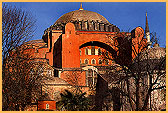|
Hagia Sophia, the Great Church
Following the destruction of the St Sophia ( )
basilica by the
Nika rioters in 532, Justinian I lay the foundations of
a new church of unprecedented prestige. Anthemius of Tralles
and Isidore of Miletus were commissioned by Justinian to design
and construct the new St Sophia. They were both mechanikoi
- that is architects with experience in engineering. St Sophia
is a five-aisled basilica covered by a huge dome. Aisles and
galleries with
columns of different sizes and proportions flank the
nave, the upper
order consciously made not to line up with the lower. The
downward thrust of the dome is carried through
pendentives,
and met by the counterthrust of four massive piers. On the
east-west axis, it is butressed by two semi-domes and four
exedrae.
Support was weaker on the north-south axis. Structural weaknesses
became apparent while construction was still in progress,
and in 558 the dome collapsed. The second dome was raised
by seven meters and surrounded by cornices which served as
levelling courses. Enormous windows pierced the side-walls
flooding the edifice with light. The sixth-century description
of the church by
Paul Silentiarios mentions
a
chancel screen with twelve
columns, its
architrave adorned with images of Christ, the
Virgin, the Apostles and angels; the parapet panels bore monograms
of Justinian and Theodora. A raised pathway, the solea, projected
from the sanctuary to the
ambo. This was
a circular or oval platform on eight posts, encircled by eight
columns separated by parapet slabs and topped by an architrave.
The
apse was lined
with the benches of the
synthronon.
The altar table was made of gold and precious stones, with
a silver
ciborium rising
over it. The splendid furnishings included thousands of lights.
Undercut impost
capitals, vast expanses of non-figural gold
mosaic and polychrome marble wall and floor revetments completed
the decoration.
the
Nika rioters in 532, Justinian I lay the foundations of
a new church of unprecedented prestige. Anthemius of Tralles
and Isidore of Miletus were commissioned by Justinian to design
and construct the new St Sophia. They were both mechanikoi
- that is architects with experience in engineering. St Sophia
is a five-aisled basilica covered by a huge dome. Aisles and
galleries with
columns of different sizes and proportions flank the
nave, the upper
order consciously made not to line up with the lower. The
downward thrust of the dome is carried through
pendentives,
and met by the counterthrust of four massive piers. On the
east-west axis, it is butressed by two semi-domes and four
exedrae.
Support was weaker on the north-south axis. Structural weaknesses
became apparent while construction was still in progress,
and in 558 the dome collapsed. The second dome was raised
by seven meters and surrounded by cornices which served as
levelling courses. Enormous windows pierced the side-walls
flooding the edifice with light. The sixth-century description
of the church by
Paul Silentiarios mentions
a
chancel screen with twelve
columns, its
architrave adorned with images of Christ, the
Virgin, the Apostles and angels; the parapet panels bore monograms
of Justinian and Theodora. A raised pathway, the solea, projected
from the sanctuary to the
ambo. This was
a circular or oval platform on eight posts, encircled by eight
columns separated by parapet slabs and topped by an architrave.
The
apse was lined
with the benches of the
synthronon.
The altar table was made of gold and precious stones, with
a silver
ciborium rising
over it. The splendid furnishings included thousands of lights.
Undercut impost
capitals, vast expanses of non-figural gold
mosaic and polychrome marble wall and floor revetments completed
the decoration.
|